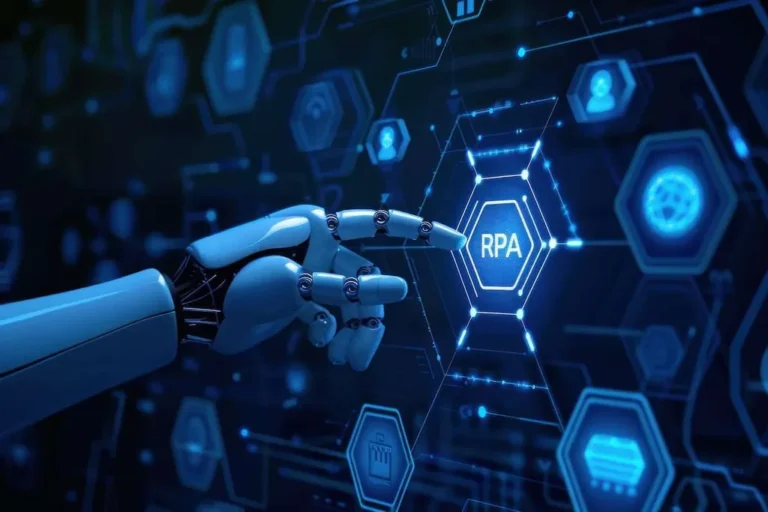RPA as a Service: Features of Robotic Process Automation Outsourcing

The robotic process automation (RPA) market is expected to exceed $11 billion in the coming years, according to AIMultiple. However, many companies hesitate to adopt RPA due to substantial implementation expenditures and complex technical requirements. This has fueled the rise of bot-as-a-service (BaaS) systems, comprising RPA-as-a-Service (RPAaaS), which provide a more flexible and resource-efficient approach. In this blog post, we’ll explore the benefits and limitations of RPAaaS and examine several key trends shaping its progress.
The Explanation of RPAaaS
RPA is an automation system that incorporates artificial intelligence (AI), optical character recognition (OCR), computer vision, and natural language processing (NLP) to imitate the interaction of human agents and PCs and facilitate routine procedures based on rules.
Standard on-premises RPA is developed using the company’s technical infrastructure with its firewalls. The business must complete the documents for the RPA software and is responsible for the design, implementation, control, and improvement of the RPA bot. Such a process mining requires significant investments in purchasing equipment, hosting infrastructure, and paying IT specialists.
RPAaaS simplifies automation deployment through the cloud, eliminating the need for users to purchase licenses. The entire infrastructure is managed by the provider, who hosts the system on their own cloud platform. Additionally, the provider handles the design, monitoring, and continuous optimization of software robots, ensuring seamless performance.
The providers are also responsible for maintaining the systems. They will train the company’s employees to work with RPA tools and tell them how to use automation most effectively.
A business that chooses RPAaaS does not have to spend huge amounts of money to purchase equipment and create an application. It pays only for the services it actually uses during the entire term.

We are confident that we have what it takes to help you get your platform from the idea throughout design and development phases, all the way to successful deployment in a production environment!
Distinctions between RPA On-Premises and RPAaaS
If you are considering using RPA in your business, there are two options: RPA on-premises and RPA as a service. Before making a choice, it is essential to evaluate the differences between the models.
| Criteria | On-Premises RPA | RPAaaS |
| Costs | Requires significant upfront and ongoing expenses, including staff salaries and IT support. However, it offers a long-term economy. | Lower initial expenditures and faster ROI, but expenditures may rise over time. |
| Deployment Period | Demands more time to install and configure software. | Quick deployment with no additional hardware or software installation required. |
| Platforms | There are many options, so each client can find the most suitable solution. | Access to the provider’s pre-built and optimized platform. |
| Access Level | The business has full control over access. | Simplified access and account management, controlled by the provider. |
| The Need for Internal Tech Team | Requires dedicated IT staff for implementation and maintenance. | Minimal staff involvement, as most tasks are handled by the provider. |
| Security | Can be fully integrated with the company’s existing security infrastructure. | Security depends on the provider’s tools and protocols. |
| Maintenance | Internal IT specialists resolve all problems. | The service is provided by the provider. |
Compare these criteria to understand which option suits your business in terms of scale, costs, and level of control.
Evaluate what is more important to you — quick payback or cost-cutting in the long term. Consider how quickly you need to launch the solution and what level of IT support your company has.
The decision between RPA on-premises and RPA SaaS depends on the capabilities and objectives of the business.

Key Benefits of RPAaaS
Advanced software offers digital transformation to companies that want to adopt robotic automation without significant initial investments. Let’s consider the main advantages of such a cloud solution.
- Cost-effective and ROI-friendly. The subscription-based pricing model means you don’t have to buy and set up infrastructure. Now even small firms have access to advanced technologies.
- Scalability. The company can increase the scope of automation as the business develops and not worry about the efficiency of the infrastructure. It is relevant for volatile markets.
- Rapid implementation. Cloud systems offer faster implementation than on-premises solutions since there is no need to install hardware and software. It allows you to start automation earlier.
- Availability. Robotic process automation as a service works through the cloud, which means it can be connected from any location. It provides access for employees from different countries and allows for global operations.
Responsible developers offer customers service and expertise to suggest methods for optimizing automation and help solve any problems.
Main Challenges Associated with RPAaaS
Although cloud RPA offers substantial benefits, many firms reject this model due to key challenges. Understanding these issues beforehand is crucial for successful implementation:
- Long-term costs. This model has advantages in terms of initial investment, but subscription payments can be significant. Firms that choose on-premises RPA, on the contrary, face a decrease in spending over time.
- Confidentiality of information. If a company delegates this activity to a third party, it must open access to information about customers and employees and to business processes. The introduction of cloud technologies with different security protocols has reduced the risks of such transactions, but many business owners are not ready to share confidential datasets.
- Level of control. By outsourcing RPA implementation to a third party, a business also loses some control. It inherits the infrastructure, policies, and security standards from the developer. The company will also have to compete with other providers’ clients for speed of service.
An RPAaS solution cannot offer customized service fully tailored to firm standards, as is the case with on-premises RPA. Operators offer standardized products that can meet the needs of organizations in different industries.
Important RPAaaS Tendencies
As RPAaaS evolves, it becomes more and more efficient. Let’s look at the main tendencies forming the progress of technology.
- Hyperautomation. It synchronizes RPA solutions and other advanced tools, including AI and machine learning (ML), to automate multifaceted workflows. RPAaaS operators are actively implementing hyperautomation to make processes in different sectors more efficient.
- AI-backed RPA. Developers add smart elements to software, e.g., ML and predictive analysis systems, to create applications that work with unstructured datasets, make rational decisions, and constantly educate. This is important so that businesses can automate not only rules-based processes.
- Synchronization with low-code or no-code platforms. With the development of low-code and no-code tools, automation is available to users with minimum technical knowledge. RPAaaS developers are adding such systems to their products so customers can implement automation without spending much time learning how to code.
These trends demonstrate how RPAaaS will improve to help organizations maintain a competitive advantage in a dynamic marketplace.
How to Use RPAaaS in Various Sectors?
Due to its multifunctionality, RPA as a Service is being implemented in various industries. Let’s look at some interesting examples.
- Banking and finance. The system analyzes the possibility of issuing a loan and monitors fraud. RPA improves interaction with staff due to quick profile setup and problem-solving.
- Healthcare. Automation improves work with personal patient records and appointment scheduling. It reduces the number of inaccuracies in compliance with legislation.
- Retail. RPA makes it easy to track inventory and process orders and returns. The system creates personalized offers for customers based on AI-ruled analytics.
- Real estate. The software automatically updates catalogs of available real estate and simplifies document flow. It activates interactions with leads and guests.
Such use cases confirm that the system adapts to the requirements of different sectors, increasing productivity and procedure accuracy.
Final Words
RPA-as-a-Service enables businesses to harness the full potential of automation with a simple and scalable model. Its benefits span multiple sectors and activities, from improving customer engagement to streamlining internal processes. RPAaaS leverages advanced AI-ruled systems and cloud computing to enhance the performance of businesses that strive to innovate.
Top Articles
RPA as a Service: Features of Robotic Process Automation Outsourcing
I am here to help you!
Explore the possibility to hire a dedicated R&D team that helps your company to scale product development.






